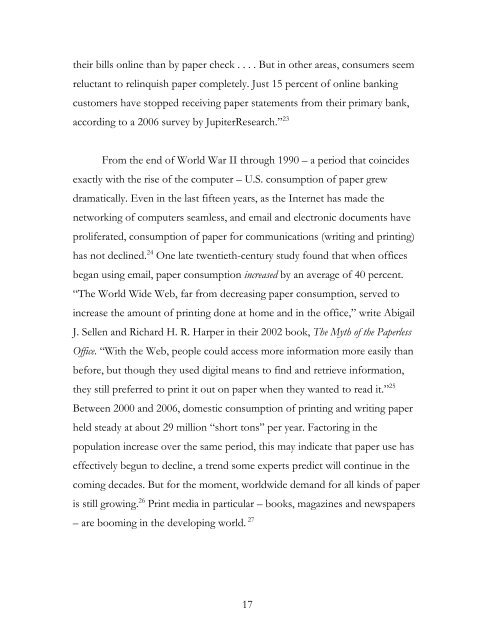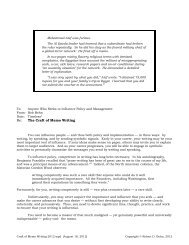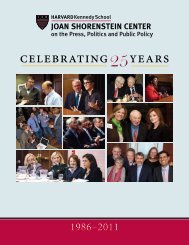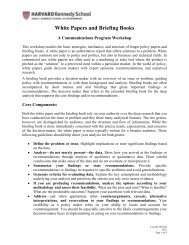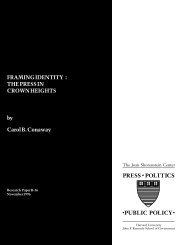Why Paper Is Eternal - Joan Shorenstein Center on the Press ...
Why Paper Is Eternal - Joan Shorenstein Center on the Press ...
Why Paper Is Eternal - Joan Shorenstein Center on the Press ...
You also want an ePaper? Increase the reach of your titles
YUMPU automatically turns print PDFs into web optimized ePapers that Google loves.
<strong>the</strong>ir bills <strong>on</strong>line than by paper check . . . . But in o<strong>the</strong>r areas, c<strong>on</strong>sumers seem<br />
reluctant to relinquish paper completely. Just 15 percent of <strong>on</strong>line banking<br />
customers have stopped receiving paper statements from <strong>the</strong>ir primary bank,<br />
according to a 2006 survey by JupiterResearch.” 23<br />
From <strong>the</strong> end of World War II through 1990 – a period that coincides<br />
exactly with <strong>the</strong> rise of <strong>the</strong> computer – U.S. c<strong>on</strong>sumpti<strong>on</strong> of paper grew<br />
dramatically. Even in <strong>the</strong> last fifteen years, as <strong>the</strong> Internet has made <strong>the</strong><br />
networking of computers seamless, and email and electr<strong>on</strong>ic documents have<br />
proliferated, c<strong>on</strong>sumpti<strong>on</strong> of paper for communicati<strong>on</strong>s (writing and printing)<br />
has not declined. 24 One late twentieth-century study found that when offices<br />
began using email, paper c<strong>on</strong>sumpti<strong>on</strong> increased by an average of 40 percent.<br />
“The World Wide Web, far from decreasing paper c<strong>on</strong>sumpti<strong>on</strong>, served to<br />
increase <strong>the</strong> amount of printing d<strong>on</strong>e at home and in <strong>the</strong> office,” write Abigail<br />
J. Sellen and Richard H. R. Harper in <strong>the</strong>ir 2002 book, The Myth of <strong>the</strong> <str<strong>on</strong>g>Paper</str<strong>on</strong>g>less<br />
Office. “With <strong>the</strong> Web, people could access more informati<strong>on</strong> more easily than<br />
before, but though <strong>the</strong>y used digital means to find and retrieve informati<strong>on</strong>,<br />
<strong>the</strong>y still preferred to print it out <strong>on</strong> paper when <strong>the</strong>y wanted to read it.” 25<br />
Between 2000 and 2006, domestic c<strong>on</strong>sumpti<strong>on</strong> of printing and writing paper<br />
held steady at about 29 milli<strong>on</strong> “short t<strong>on</strong>s” per year. Factoring in <strong>the</strong><br />
populati<strong>on</strong> increase over <strong>the</strong> same period, this may indicate that paper use has<br />
effectively begun to decline, a trend some experts predict will c<strong>on</strong>tinue in <strong>the</strong><br />
coming decades. But for <strong>the</strong> moment, worldwide demand for all kinds of paper<br />
is still growing. 26 Print media in particular – books, magazines and newspapers<br />
– are booming in <strong>the</strong> developing world. 27<br />
17


